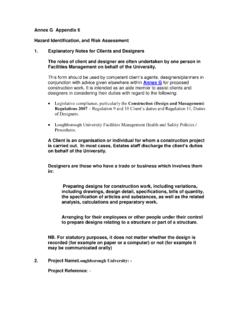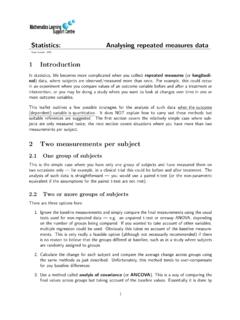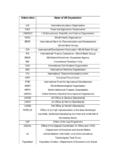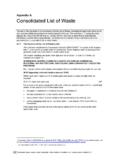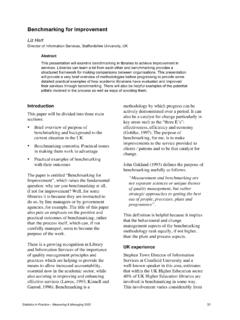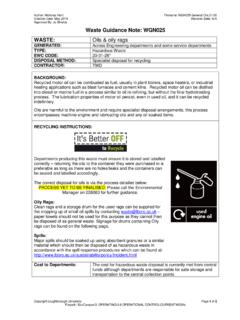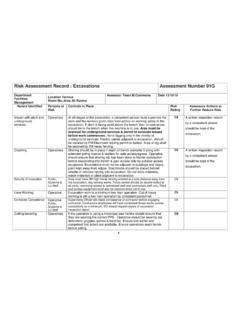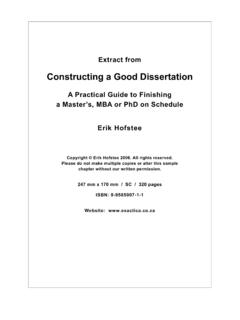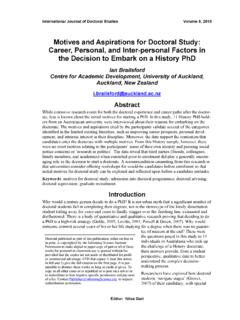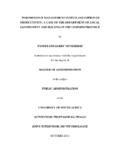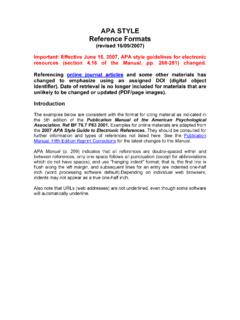Transcription of Innovation in the design of continuous flight auger and ...
1 Innovation in the design of continuous flight auger and bored displacement piles David James Baxter Rock and Alluvium Ltd. Bridge House 27 Bridge Street Leatherhead Surrey KT22 8BL Centre for Innovative and Collaborative Engineering Department of Civil & Building Engineering Loughborough University Loughborough Leicestershire LE11 3TU Innovation IN THE design OF continuous flight auger AND BORED DISPLACEMENT PILES By David James Baxter A dissertation thesis submitted in partial fulfilment of the requirements for the award of the degree Doctor of Engineering (EngD), at Loughborough University [June 2009] by David James Baxter 2009 Rock and Alluvium Ltd. Bridge House 27 Bridge Street Leatherhead Surrey KT22 8BL Centre for Innovative and Collaborative Engineering Department of Civil & Building Engineering Loughborough University Loughborough Leicestershire LE11 3TU Acknowledgements ACKNOWLEDGEMENTS This research was made possible through funding from the Engineering and Physical Sciences research Council and from Rock and Alluvium Ltd, for this I would like to express my sincere gratitude.
2 I would like to thank my Academic Supervisors at Loughborough University, Dr Paul Fleming and Professor Neil Dixon, for their generous and plentiful support, guidance and advice throughout the research period. Thanks are also extended to Dr Ashraf El-Hamalawi who regularly provided a fresh perspective. I would also like to thank all of the staff, past and present, at Rock and Alluvium who have helped me throughout this research . In particular I would like to show my appreciation for the efforts of my Industrial Supervisors Steve Hadley and Ken Cromwell, who have provided direction, advice and practical insight as well as the time and resources necessary to follow my research interests. The support of the Centre for Innovative and Collaborative Engineering has also been much appreciated.
3 I would particularly like to acknowledge the guidance received from Professor Dino Bouchlaghem and Professor Chimay Anumba and the assistance of Jo Brewin, Colette Bujdoso, Sara Cowin, and Nadine Smith. The time and efforts of the examiners, Dr Matthew Frost, Dr Charles Hird and Dr Matthew Raybould are greatly appreciated, as is the feedback they provided. There are numerous friends and fellow research Engineers who have, whether they know it or not, helped me to stay the course. Finally my deepest gratitude goes to my wife, Jenny, for her patience, understanding, support and encouragement and of course to my children, Sophia and Thomas, who have made me smile every day no matter what. i Innovation in the design of continuous flight auger and bored displacement piles ABSTRACT The field of pile design and construction in the United Kingdom is currently in a period of change.
4 Not only are new processes and techniques being developed but also the legislative landscape is changing with the introduction of new Europe wide normative standards (BSI, 2004, 2007). This project sought to optimise pile design through better understanding and interpretation of ground conditions and of the pile-soil interaction for two pile types, continuous flight auger and bored displacement piles. Quantitative methods for interpreting and summarising previous knowledge and experience have been developed; the strata are divided into discrete bands and properties are represented with summary statistics. Experience and previous knowledge relating to the shear strength of London Clay have been quantified and presented using this approach.
5 Furthermore, a straightforward tool has been provided for the implementation of such data into design ; the previous knowledge and new site specific data are combined using Bayesian updating. Through use of this technique, the uncertainty associated with interpreting ground conditions from site data has been demonstrated to be reduced. The techniques described have been adopted into design practice within the sponsoring company. Bored displacement piles are a relatively new pile type. There is little published data or scientific understanding of the processes undergone by the soils during and after construction and the effect that these have on pile performance. This research identified the need for, and developed, a unified framework of descriptors for the various types of bored displacement pile and investigated the installation energy and performance of bored displacement piles in London Clay.
6 The energy to construct the pile was observed to be highly variable and not directly related to capacity. Performance of bored displacement piles was observed to be similar to continuous flight auger piles of similar dimensions; typical values for the adhesion between bored displacement piles and the surrounding soil were established and these were comparable to those achieved by continuous flight auger piles. ii Abstract In addition, to enable the analysis of the probability of failure of a pile, the sources of variation have been investigated and the variability quantified. Besides the soil conditions, the dimensions of the pile, notably pile diameter, were found to be a significant source of variation.
7 KEY WORDS Piles and piling, design methods, ground modelling, London Clay, bored displacement piling, continuous flight auger piling, case histories. iii Innovation in the design of continuous flight auger and bored displacement piles iv Preface PREFACE This thesis presents the research conducted from 2005 to 2008 to fulfil the requirements of an Engineering Doctorate (EngD) at the Centre for Innovative and Collaborative Engineering (CICE), Loughborough University, United Kingdom. An industrial context for the research was provided through collaboration with Rock and Alluvium Ltd, a UK based specialist piling contractor. The research was also funded by the Engineering and Physical Sciences research Council (EPSRC). The core of the EngD is the solution of one or more significant and challenging engineering problems within an industrial context.
8 The problems are identified with the industrial partner such that the research has direct relevance to the business and provides demonstrable benefit. The research must not only innovate but also demonstrate implementation of that Innovation . This thesis provides the aim, objectives, methodology, findings and industrial impact and implications of the research . The collection of published papers, which is appended to this thesis , forms an integral part of the research and these should be read in conjunction with the main text. The papers are referenced from within the discourse and provide further in-depth technical detail. v Innovation in the design of continuous flight auger and bored displacement piles USED ACRONYMS / ABBREVIATIONS bA area of the base of the pile sA area of the pile shaft in contact with the soil BD bored displacement ac average adhesion (between soil and pile) bC undrained shear strength at base of pile c average undrained shear strength CBD Chessington BD test pile.
9 CFA continuous flight auger CRP constant rate of penetration pile load test uc undrained shear strength d depth (below ground level) E Expected Frequency sE screwing in energy F factor of safety F factor of safety with a parameter decreased by 1 standard deviation F factor of safety with a parameter increased by 1 standard deviation F mean factor of safety MLVF factor of safety associated with most likely value Ip plasticity index iM torque applied to an auger ML maintained load pile load test MLV most likely value N standard penetration resistance (SPT blow count) n number of sample points cN bearing capacity factor dN vertical thrust of an auger in rotational speed of an auger O Observed frequency vi Used Acronyms / Abbreviations fP probability of failure ltheoreticaQ theoretical.
10 Calculated capacity actualQ actual observed capacity bQ base/end bearing resistance Ncq1 cone resistance sQ frictional shaft resistance uQ ultimate pile resistance R2 correlation coefficient SPT standard penetration test s standard deviation of a sample fv coefficient of variation of factor of safety iv vertical speed of an auger xv coefficient of variation WBD1 Wimbledon BD test pile number 1 w Moisture content wL Liquid limit WBD2 Wimbledon BD test pile number 2 WCFA Wimbledon CFA test pile x sample value x mean of a sample kx characteristic value mx mean shear strength within a depth band adhesion factor F change in factor of safety mean of a population mean of prior distribution mean of posterior data standard deviation of a population standard deviation of prior data ' standard deviation of posterior distribution F standard deviation of factor of safety 2 variance Degrees of freedom vii Innovation in the design of continuous flight auger and bored displacement piles 2test Chi squared test statistic 2%5 Chi squared distribution and 5% significance area of the borehole i refers to the screwing in phase viii Table of Contents TABLE OF CONTENTS i Abstract.
